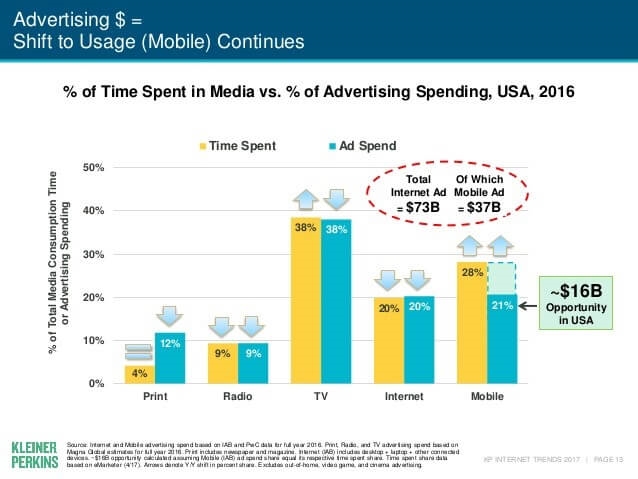To help you stay ahead and capitalize on future advertising trends, columnist David Rodnitzky rounds up the new marketing channels that he expects will emerge over the next three to five years.

The average American sees several hundred ads a day (PDF) as they peruse the internet, watch TV or consume other ad-supported media.
Surprisingly, this number has remained fairly constant since the end of World War II. We may see ads in different places today than we did years ago, but the number of ads isn’t substantially larger.
Advertisers have traditionally been laggards when moving dollars from declining to emerging marketing channels, as Mary Meeker has shown time and time again:

This presents an opportunity for savvy advertisers: By shifting budget to growing channels before the crowds, a smart advertiser can capitalize on high inventory and low competition — an arbitrage play.
In the past, I’ve written about the arc of internet marketing channel adoption. The arc has three stages:
- No one cares; no one spends any money.
- Everyone cares (e.g., keynote speeches at marketing conferences!); no one spends any money.
- No one cares; everyone spends money.
Getting in on a channel in stage one or stage two is where the arbitrage opportunity exists. With that in mind, I thought I’d put on my futurist hat and try to identify some of the new advertising channels that will emerge over the next three to five years.
Here are my top five (ranked in order of likelihood):
1. Smart home devices
Google, Apple and Amazon are all investing billions of dollars into smart home devices, from Google Home and Amazon’s Alexa to the Nest thermometer.
To date, these devices have no advertising component to them, but it’s inevitable that this will change. After all, the devices are collecting incredibly valuable behavioral data about users that advertisers will pay handsomely for.
2. The sharing economy
While Airbnb appears to be making a profit, Uber clearly is not. To date, this has not fazed investors, who have pushed Uber’s private market valuation as high as $70 billion.
At some point — especially if Uber goes public — investors will start to expect the company to drive profit. At that point, it’s going to make difficult decisions that could impact growth, like raising fares or reducing payments to drivers.
Imagine, however, if every Uber had a video monitor that ran in-car ads (not unlike taxis), or even digital billboards on top of the cars. If Uber kept 80 percent of the revenue and gave 20 percent to drivers, they might be able to continue their growth while eking out a profit.
Airbnb, by the way, could also get in on the advertising game – why not have every AirBnB outfitted with a welcome basket with a suite of coupons for local attractions (all paying AirBnB an affiliate commission)?
3. Virtual reality (VR)
There are already plenty of mobile games that use in-app advertising to monetize “free” games. As virtual reality takes off (some say it will grow to a $75 billion business by 2021!), why wouldn’t we see VR ad growth as well? For example, a car ad that lets you walk around the car, sit inside, and even test-drive it — all from the comfort of your living room.
One company, Omnivert, already claims to have served more than 500 million VR ads to date.
4. Augmented reality (AR)
Not to be confused with VR, AR is technology that augments your everyday activities. Google Glass is probably the most well-known example to date.
Once this technology is commonplace, a walk down the cereal aisle at the supermarket will likely include some virtual coupons, right inside your glasses.
5. Connected and self-driving cars
Virtually every car produced today has Bluetooth technology. As self-driving cars become street-legal, expect your car to have a large computer-like screen and a strong WiFi connection. Given that “drivers” will no longer exist, a long commute will involve surfing the web, watching content, and — you guessed it — a slew of ads.
When thinking about these new channels, remember that they are likely to be replacements of existing channels, rather than supplements.
If history is correct, the number of ads we will see on a daily basis will not increase in the future, which means that — like the first law of thermodynamics — ads can neither be created nor destroyed; they can just be transformed from one form to another. So missing out on a new channel literally means a decline in your potential advertising opportunity.
Some opinions expressed in this article may be those of a guest author and not necessarily Marketing Land. Staff authors are listed here.
Marketing Land – Internet Marketing News, Strategies & Tips
(75)
